On
Friday, 6 January CE 548,
the Jerusalem church celebrated Christmas for the last time on this
date
as the Western church moved to celebrating the birth of Jesus Christ
on December 25,
the
grinch who
stole the story
of christmas
 December
13, 2012 December
13, 2012
|
Hark!
The Herald Angels Didn’t Sing
T. M. LUHRMANN
Professor of anthropology at Stanford University
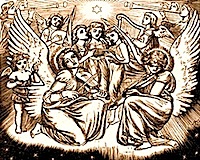 We
are in Advent, but over the transom has come the sobering
news that Image Books has just published a book written by
the pope, “Jesus of Nazareth: The Infancy Narratives,”
in which he observes that there was neither an ox nor a donkey
in the stable where Jesus was born. Nor did a host of angels
sing. They spoke. We
are in Advent, but over the transom has come the sobering
news that Image Books has just published a book written by
the pope, “Jesus of Nazareth: The Infancy Narratives,”
in which he observes that there was neither an ox nor a donkey
in the stable where Jesus was born. Nor did a host of angels
sing. They spoke.
 He writes: “In the Gospel there is no reference to animals
at this point. But prayerful reflection, reading Old and New
Testaments in the light of one another, filled this lacuna
at a very early state by pointing to Isaiah 1:3: ‘The
ox knows its owner, and the ass its master’s crib, but
Israel does not know.’ ” A few pages later,
the pope explains that “Christianity has always understood
that the speech of angels is actually song.
He writes: “In the Gospel there is no reference to animals
at this point. But prayerful reflection, reading Old and New
Testaments in the light of one another, filled this lacuna
at a very early state by pointing to Isaiah 1:3: ‘The
ox knows its owner, and the ass its master’s crib, but
Israel does not know.’ ” A few pages later,
the pope explains that “Christianity has always understood
that the speech of angels is actually song.
|
KRAMPUS
He Sees You When You’re Sleeping
and Gives You Nightmares
MUNICH JOURNAL
By MELISSA EDDY
THE NEW YORK TIMES
DEC. 21, 2014
Long before parents relied on the powers of Santa Claus to
monitor their children’s behavior, their counterparts
in Alpine villages called on a shaggy-furred, horned creature
with a fistful of bound twigs to send the message that they
had better watch out.
|
Santa Claus and Satan's Cause |
|
|
|
|
"A
wink of his eye, and a twist of his head,
soon led me to know I had nothing to dread."
Twas'
the Night Before Christmas
Clement C. Moore
The
fact is that Santa and Satan are alter egos,
brothers; they have the same origin.
On the surface, the two figures are polar opposites,
but underneath they share the same parent, and
both retain many of the old symbols associated
with their "father" . . . From these
two paths, he arrived at both the warmth of
our fireplace and in the flames of hell. |
|
|
THE
TRUE STORY
December
25 was the birthday of the sun-god, Mithras,
a 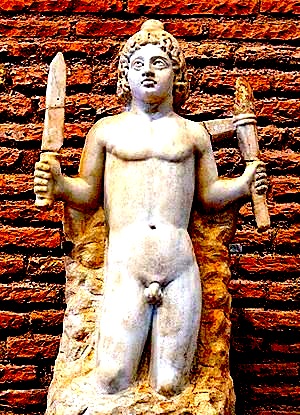 deity
whose religious influence was widespread in the Roman Empire, popular
in the Roman military, during the first centuries of the present
era. Mithras was identified with the Semitic sun-god Shamash, whose
worship spread from Asia to the west where he was worshipped as Deus
Sol Invictus (the invincible Sun) Mithras throughout the Roman Empire.
He drives across the sky in a chariot of gold, the Sun being his eye.
deity
whose religious influence was widespread in the Roman Empire, popular
in the Roman military, during the first centuries of the present
era. Mithras was identified with the Semitic sun-god Shamash, whose
worship spread from Asia to the west where he was worshipped as Deus
Sol Invictus (the invincible Sun) Mithras throughout the Roman Empire.
He drives across the sky in a chariot of gold, the Sun being his eye.
Mithras was born in a cave from Petra, the sacred rock, who later
became Peter, the foundation of the Christian Church. He is believed
to be a Mediator between God and man, between the Sky and the Earth.
It also became the belief of the early Christian world that Mithra
was born of [a] Virgin. He traveled far and wide. He has twelve satellites,
which are taken as the Sun's disciples. The Sun's great festivals
are observed in the Winter Solstice and the Vernal Equinox, i.e. Christmas
and Easter.
There
Goes the Sun
By RICHARD COHEN, OP-ED CONTRIBUTOR
Author
of “Chasing the Sun:
The Epic Story of the Star That Gives Us Life”
 December
20, 2010 December
20, 2010
|
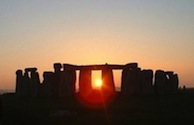 WHAT
is the winter solstice, and
why bother to celebrate it, as so many people
around the world will tomorrow? The word “solstice”
derives from the Latin sol (meaning sun) and statum (stand still),
and reflects what we see on the first days of summer and winter when,
at dawn for two or three days, the sun seems to linger for several
minutes in its passage across the sky, before beginning to double
back.
WHAT
is the winter solstice, and
why bother to celebrate it, as so many people
around the world will tomorrow? The word “solstice”
derives from the Latin sol (meaning sun) and statum (stand still),
and reflects what we see on the first days of summer and winter when,
at dawn for two or three days, the sun seems to linger for several
minutes in its passage across the sky, before beginning to double
back.

 Indeed, “turnings of the sun”
is an old phrase, used by both Hesiod
(> left)
and Homer (>
right). The novelist Alan Furst
has one of his characters nicely observe, “the
day the sun is said to pause. ... Pleasing, that idea. ... As though
the universe stopped for a moment to reflect, took a day off from
work. One could sense it, time slowing down.”
Indeed, “turnings of the sun”
is an old phrase, used by both Hesiod
(> left)
and Homer (>
right). The novelist Alan Furst
has one of his characters nicely observe, “the
day the sun is said to pause. ... Pleasing, that idea. ... As though
the universe stopped for a moment to reflect, took a day off from
work. One could sense it, time slowing down.”
 Virtually
all cultures have their own way of acknowledging this moment.
The Welsh word for solstice [Byrddydd]
translates as “the point of roughness”
[when Rhiannon (left)
gave birth to the sacred son, Pryderi] while the Talmud
calls it “Tekufat Tevet,”
first day of “the stripping time.”
For the Chinese, winter’s
Virtually
all cultures have their own way of acknowledging this moment.
The Welsh word for solstice [Byrddydd]
translates as “the point of roughness”
[when Rhiannon (left)
gave birth to the sacred son, Pryderi] while the Talmud
calls it “Tekufat Tevet,”
first day of “the stripping time.”
For the Chinese, winter’s 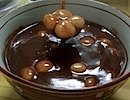
 beginning
is “dongzhi,” (>
left) when one tradition is making balls
of glutinous rice, which symbolize family gathering. In Korea,
these balls are mingled with a sweet red bean
called pat jook (>
right). According to local lore, each
winter solstice a ghost comes to haunt
beginning
is “dongzhi,” (>
left) when one tradition is making balls
of glutinous rice, which symbolize family gathering. In Korea,
these balls are mingled with a sweet red bean
called pat jook (>
right). According to local lore, each
winter solstice a ghost comes to haunt  villagers.
The red bean in the rice balls repels him.
villagers.
The red bean in the rice balls repels him.
 In
parts of Scandinavia, the locals
smear their front doors with butter so that Beiwe,
sun goddess of fertility [and sanity] (left),
can lap it up before she continues on her journey. (One wonders who
does all the mopping up afterward.) Later, young
women don candle-embedded helmets, while families go to bed
having placed their shoes all in a row, to ensure peace over the coming
year.
In
parts of Scandinavia, the locals
smear their front doors with butter so that Beiwe,
sun goddess of fertility [and sanity] (left),
can lap it up before she continues on her journey. (One wonders who
does all the mopping up afterward.) Later, young
women don candle-embedded helmets, while families go to bed
having placed their shoes all in a row, to ensure peace over the coming
year.
 Street
processions are another common feature. In Japan,
young men known as “sun devils,”
their faces daubed to represent their imagined solar ancestry,
still go among the farms to ensure the earth’s
fertility (and their own stocking-up with alcohol). In Ireland,
people called wren-boys take to the roads,
wearing masks or straw suits. The practice
used to involve the killing of a wren, and singing
songs while carrying the corpse from house to house.
Street
processions are another common feature. In Japan,
young men known as “sun devils,”
their faces daubed to represent their imagined solar ancestry,
still go among the farms to ensure the earth’s
fertility (and their own stocking-up with alcohol). In Ireland,
people called wren-boys take to the roads,
wearing masks or straw suits. The practice
used to involve the killing of a wren, and singing
songs while carrying the corpse from house to house.

wren
Sacrifice
is a common thread. In areas of northern
Pakistan, men have 
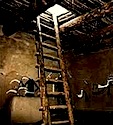 cold
water poured over their heads in purification, and are forbidden to
sit on any chair till the evening, when their heads will be sprinkled
with goats’ blood. (Unhappy goats.) Purification
is also the main object for the Zuni
and Hopi tribes of North America, their
attempt to recall the sun from its long winter slumber. It
also marks the beginning of another turning of their
“wheel of the year,”
and kivas (sacred
underground ritual chambers, right)
are opened to mark the season.
cold
water poured over their heads in purification, and are forbidden to
sit on any chair till the evening, when their heads will be sprinkled
with goats’ blood. (Unhappy goats.) Purification
is also the main object for the Zuni
and Hopi tribes of North America, their
attempt to recall the sun from its long winter slumber. It
also marks the beginning of another turning of their
“wheel of the year,”
and kivas (sacred
underground ritual chambers, right)
are opened to mark the season.
Yet, for all these symbolisms, this time remains at
heart an astronomical event, and quite a curious one. In summer, the
sun is brighter and reaches higher into the sky, shortening the shadows
that it casts; in winter it rises and sinks closer to the horizon,
its light diffuses more and its shadows lengthen. As the winter hemisphere
tilts steadily further away from the star, daylight becomes shorter
and the sun arcs ever lower. Societies that were organized around
agriculture intently studied the heavens, ensuring that the solstices
were well charted.
Despite their best efforts, however, their priests and stargazers
came  to
realize that it was exceptionally hard to pinpoint the moment of the
to
realize that it was exceptionally hard to pinpoint the moment of the
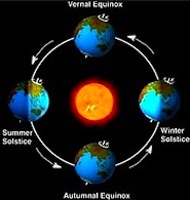 sun’s
turning by observation alone — even though they could define
the successive seasons by the advancing and withdrawal of daylight
and darkness.
sun’s
turning by observation alone — even though they could define
the successive seasons by the advancing and withdrawal of daylight
and darkness.
The earth further complicates matters. Our globe tilts on its axis
like a spinning top, going around the sun at an angle to its orbit
of 23 and a half degrees. Yet the planet’s shape changes minutely
and its axis wobbles, thus its orbit fluctuates. If its axis remained
stable and if its orbit were a true circle, then the equinoxes and
solstices would quarter the year into equal sections. As it is, the
time between the spring and fall equinoxes in the Northern Hemisphere
is slightly greater than that between fall and spring, the earth —
being at that time closer to the sun — moving about 6 percent
faster in January than in July.
The
apparently supernatural power manifest in solstices to govern the
seasons has been felt as far back as we know, inducing different reactions
from different cultures — fertility rites, fire festivals, offerings
to the gods. Many of the wintertime customs in Western Europe descend
from the ancient Romans, who believed that their god
of the harvest, Saturn, had ruled
the land during an earlier age of abundance, and so celebrated the
winter solstice with the Saturnalia,
a feast of gift-giving, role-reversals (slaves berating their masters)
and general public holiday from Dec. 17 to 24.

The transition from Roman paganism to Christianity,
with its similar rites, took several 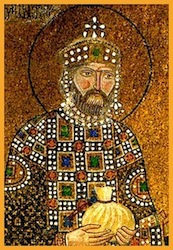
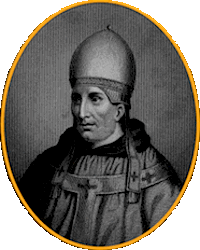 centuries.
With the Emperor Constantine’s
conversion to Christianity in the fourth century,
customs were quickly appropriated and refashioned,
as the sun and God’s son became inextricably entwined. Thus,
although the New Testament gives no indication of Christ’s actual
birthday (early writers preferring a spring date), in
354 Pope Liberius declared it to have
befallen on Dec. 25.
centuries.
With the Emperor Constantine’s
conversion to Christianity in the fourth century,
customs were quickly appropriated and refashioned,
as the sun and God’s son became inextricably entwined. Thus,
although the New Testament gives no indication of Christ’s actual
birthday (early writers preferring a spring date), in
354 Pope Liberius declared it to have
befallen on Dec. 25.
The advantages of Christmas Day being celebrated then were obvious.
As the Christian commentator Syrus wrote:
“It was a custom of the pagans to celebrate
on the same Dec. 25 the birthday of the sun,
at which they kindled lights in token of festivity .... Accordingly,
when the church authorities perceived that the Christians had a leaning
to this festival, they took counsel and resolved that the true
Nativity should be solemnized on that day.”
In Christendom, the Nativity gradually absorbed
all other winter solstice rites, and the co-opting of solar imagery
was part of the same process. Thus the solar
discs that had once been depicted behind the heads of Asian
rulers became the halos of Christian
luminaries.
|
|
|
|
|
Egypt
- Ra |
Buddha |
Buddha |
Roman
- Apollo |
Christian
|
Despite
the new religion’s apparent supremacy, many of the old customs
survived — so much so that church elders worried that the veneration
of Christ was being lost. In the fifth century, St.
Augustine of Hippo and Pope Leo the Great felt compelled to
remind their flocks that Christ, not the sun, was their proper object
of their worship.


While Roman Christianity was the dominant
culture in Western Europe, it was by
no means the only one. By millennium’s end, the Danes
controlled most of England, bringing with them “Yule,”
their name for winter solstice celebrations, probably derived from
an earlier term for “wheel.” For centuries, the most sacred
Norse symbol had been the
wheel of the heavens, represented by a six-
or eight-spoked wheel or by a cross within
a wheel signifying solar rays [the symbol
adopted by Opus Dei, (right)].
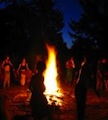
 The
Norse peoples, many of whom settled in what is now Yorkshire,
would construct huge solar wheels and place
them next to hilltop bonfires, while in
the Middle Ages processions bore wheels upon chariots or boats.
In other parts of Europe, where the Vikings
were feared and hated, a taboo on using spinning
wheels during solstices lasted well into the 20th century.
The spinning-wheel on which Sleeping
Beauty pricks her finger may exemplify this sense of menace.
The
Norse peoples, many of whom settled in what is now Yorkshire,
would construct huge solar wheels and place
them next to hilltop bonfires, while in
the Middle Ages processions bore wheels upon chariots or boats.
In other parts of Europe, where the Vikings
were feared and hated, a taboo on using spinning
wheels during solstices lasted well into the 20th century.
The spinning-wheel on which Sleeping
Beauty pricks her finger may exemplify this sense of menace.
Throughout much of Europe, at least up
until the 16th century, 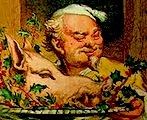 starvation
was common from January
to April, a period known as “the famine months.”
Most cattle were slaughtered so they would not have to be fed over
the winter, making the solstice almost the only time of year that
fresh meat was readily available. The boar’s
head at Christmas feasts represents the dying
sun of the old year, while the suckling
pig — with the apple of immortality in its mouth —
the new.
starvation
was common from January
to April, a period known as “the famine months.”
Most cattle were slaughtered so they would not have to be fed over
the winter, making the solstice almost the only time of year that
fresh meat was readily available. The boar’s
head at Christmas feasts represents the dying
sun of the old year, while the suckling
pig — with the apple of immortality in its mouth —
the new.
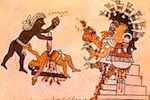 The
turning of the sun was perhaps even more important in the New World
than the Old. The Aztecs, who
believed that the heart harbored elements of
the sun’s power, ensured its continual well-being by
tearing out this vital organ from hunchbacks,
dwarves or prisoners of war, so releasing the “divine
sun fragments” entrapped by the body and its desires.
The
turning of the sun was perhaps even more important in the New World
than the Old. The Aztecs, who
believed that the heart harbored elements of
the sun’s power, ensured its continual well-being by
tearing out this vital organ from hunchbacks,
dwarves or prisoners of war, so releasing the “divine
sun fragments” entrapped by the body and its desires.
 The
Incas would celebrate the solar festival of Inti
Raymi by having their priests attempt to tie down the celestial
body. At Machu Pichu, high in the Peruvian
Andes, there is a large stone column called the Intihuatana,
(“hitching post of the sun,”) to which the star
would be symbolically harnessed. It is unclear how the Incas measured
the success of this endeavor, but at least the
sun returned the following day.
The
Incas would celebrate the solar festival of Inti
Raymi by having their priests attempt to tie down the celestial
body. At Machu Pichu, high in the Peruvian
Andes, there is a large stone column called the Intihuatana,
(“hitching post of the sun,”) to which the star
would be symbolically harnessed. It is unclear how the Incas measured
the success of this endeavor, but at least the
sun returned the following day.
Yet above all other rituals, reproducing the
sun’s fire by kindling flame on earth is the commonest solstice
practice, both at midsummer and midwinter. Thomas
Hardy, describing Dorset villagers
around a bonfire in “The Return of the
Native,” offers an explanation for such a worldwide phenomenon:
“To light a fire is the instinctive
and resistant act of men when, at the winter ingress, the curfew is
sounded throughout nature. It indicates a spontaneous, Promethean
rebelliousness against the fiat that this recurrent season shall bring
foul times, cold darkness, misery and death. Black chaos comes, and
the fettered gods of the earth say, ‘Let
there be light.’ ”
So there is good reason to celebrate the winter
solstice — but maybe that celebration is still touched with
a little fear.
|
|
Click
√ on cover to order
|
Celestial
Holidays
EDITORIAL
The New York Times: December 21, 2010
This
is it, the shortest day of the year, the longest night.
Winter, which begins Tuesday at 6:38 p.m. Eastern
time, will get no darker than this. Slowly, inexorably, the
days will begin to yawn wider and wider, and night will begin to contract.
The change is just a few seconds at first — New
Year’s Eve in Manhattan will be only 28 seconds longer than
Christmas Eve. By mid-March, the days will be growing by some
2 minutes and 40 seconds apiece, and then the rate of change slows
again until late June.
We come to the winter solstice with mixed feelings. It will be lovely
to have more light in the day. But there’s something equally
wonderful about these long hibernal nights. By 4:30 every day —
just as the sun is disappearing — we start to feel a little
ursine, ready to dig a hole and sleep away the winter. How different
our species would be if only we’d learned that one great trick!
We are all deeply habituated, in this northern clime, to the annual
accordioning of the day — so much so that an equatorial place
like Quito, Ecuador, where the length of day changes only by a second
from solstice to solstice, sounds almost like a city out of science
fiction. In some ways, that daily constancy seems more disorienting
here, where the length of day changes by almost six hours, than the
reversal of seasons in the Southern Hemisphere, where Christmas comes
in summer.
Another important astronomical holiday follows
soon after the winter solstice (which included a lunar eclipse).
At 2 p.m., New York time, on Jan. 3, the Earth
reaches Perihelion —
the closest approach to the Sun in our elliptical orbit, a little
more than 91 million miles away.
For some reason, this is a moment that
goes uncelebrated, entirely unheralded. So we say to you all,
Merry
Solstice and have a Happy Perihelion!
A FELICITOUS FESTIVUS TO ALL!

“Attack the myth that Christianity owns
the Solstice season.”
~ DAVID SILVERMAN
President
of American Atheists
EXPOSE
YOURSELF
TO
THE TRUTH!

